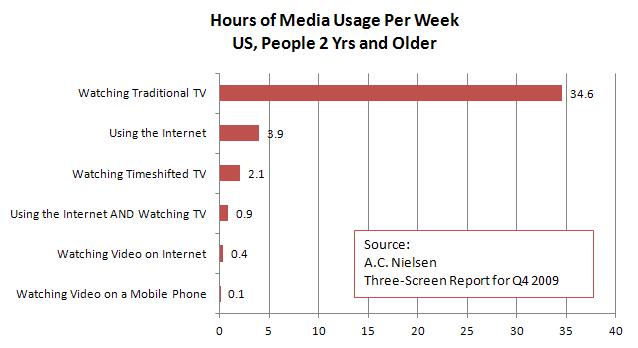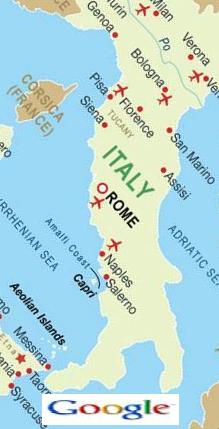The Digital Nervous System
Aug 20, 2010 Industry News, Marketing And Advertising Analytics, Statistics, Web Analytics
The web can function like a giant extension of the human nervous system. Like a spider at the center of a giant global web, you can collect and observe streams of data coming from all over the digital expanse: searches, tweets, forums, blogs, newspaper and magazine sites, press releases, Facebook and LinkedIn. Each time someone looks for or mentions your company or your product you are alerted, and you can choose in that moment to respond to it, ignore it or wait until you have more information.
Does this sound like anything you are doing now? Someone should be doing this for your company, because marketing has increasingly become an ongoing series of conversations (whether you participate in the conversation or not).
EXPERIMENT: DETECTING INSTANT RESPONSE TO MEDIA WITH THE INTERNET
There are several national TV shows that frequently have book authors as guests (the Daily Show, The Colbert Report, The Today Show, Good Morning America). The next time you find yourself in front of one of these shows when an author is on plugging their book, try the following experiment (this will work best with a show with a national audience):
1. Fire up your laptop and go to amazon.com
2. Search in the Books category for the title of the book the author is plugging on the show you are watching
3. Click to the Amazon page for that book.
4. Scroll down past the synopsis and the reviews to the section labelled Product Details. It should look something like this:
The number I have circled is the book’s current sales rank on Amazon.
5. Every few minutes while the author is on the show and for a while after that (until you bore of this experiment), hit function key f5 to refresh the page and watch what happens to the book’s sales ranking.
The rank should get better – in real time – as you are sitting there. I have done this several times when my brother-in-law has done TV appearances to promote his books, and it is amazing. Once he was on Oprah Winfrey and we saw the sales rank improve precipitously from 20-something into the top 10 while he was being interviewed.
Now imagine all the other analogous information streams there are available on the internet. If you could get the monitoring automated, just think of how quickly you will know exactly what the world thinks of your new site, your new ad campaign, your new product. Just think of what you’d be missing by NOT knowing.
EXTRA CREDIT EXPERIMENT #1 – THE TWITTER BUMP
In between rank checks you should do check in on Twitter searches for the author’s name and the book’s name. These should also pop during the author’s TV appearance.
EXTRA CREDIT EXPERIMENT #2 – THE GOOGLE BUMP
After a day or so you should go to Google Trends and see what happened to searches for the author’s name and the book’s name. These should’ve spiked on the day the author did the TV appearance. Google Trends doesn’t provide much flexibility about getting more granular (in time) data in a more real-time way, and it looks like the beta for Google Insights for Search has a latency of a couple of days.
GOOGLE EPIDEMIOLOGY – WHO KNEW THEY COULD DO THAT?
Take a look at the Google Flutrends project (http://www.google.org/flutrends) and you can see what an amazingly useful datasource this would be with access to the full detail in realtime. It turns out that counting Google searches for flu information is a quicker detector of flu epidemics than CDC reports are.
I believe it would be just as accurate in detecting other kinds of contagion sweeping through the world: fads, emerging trends, scares, rumors, accidents, disasters – this is the kind of information that businesses need to know when it involves their products, their brands, or their markets.
Tags: Amazon Book Rankings, Amazon.com, Digital Nervous System, Google Search Insights, Google Trends, Listening programs, Real-time trend detection, Social Media Montoring, Twitter
Digital Marketers Should Not Act As If TV Doesn’t Exist (There’s An Elephant in the Room)
May 26, 2010 Industry News
A lot of digital media analysis is very compartmentalized, meaning that the effectiveness of social media focuses exclusively on direct measures of social media and measures of desired outcomes. I think this is very risky. By not including causal variables like spending in adjacent marketing channels (in this case search, email, and display) or nearly ubiquitous channels (TV), you run the risk of confusing the effects of your efforts with the impact of exogenous factors you do not control.
Let’s say you are analyzing the digital marketing efforts for a client that invests heavily in websites, display advertising, paid search, SEO, email, and social media. Let’s say they are also big spenders in traditional media, like TV for instance. Analyzing the effectiveness of your online efforts without have some measure of tv spending or exposure in your mix of causal variables is a bit like trying to say never mind the sun, your flashlight caused the day to begin. That’s an exaggeration, but take a look at the average weekly usage numbers from the Q4 2009 edition of the Nielsen Three-Screen Report (http://en-us.nielsen.com/main/insights/nielsen_a2m2_three):
People watch their TVs nearly nine times longer per week than they use the internet. Also, TVs reach more households than the internet. I’m not saying every analysis needs to be a marketing mix analysis, but you don’t want to do a sailing analysis without looking at wind as a causal variable. If I think of any more dumb metaphors, I’ll add them as comments.
Tags: Campaign Analysis, Digital Agencies, Digital Marketing, Digital Marketing and TV, Marketing Analytics, Marketing Mix, Nielsen, Nielsen Three Screen Report, Television and Interactive Marketing
Evidence-Based Marketing Experiencing A Wave of Growth?
Apr 27, 2010 Industry News
While news stories abound about the gradual and imperceptible movement of the U.S. economy toward recovery, it is apparent to me that there is one niche which is taking off ahead of the general recovery: services related to evidence-based marketing.
What is evidence-based marketing? It is an approach to marketing that attempts to make marketing decisions and manage marketing activities – as much as possible – based on evidence: measurements, information, facts, data. This is being fueled, I think, by two factors:
1. The data-rich experience that advertisers have had as they have immersed themselves in the world of digital marketing
2. The tremendous pressure that a down economy has placed on marketers to provide evidence that the money they spend is well-spent
As an evidence-based marketer myself, I would not have arrived at this conclusion without… well, evidence. As someone who does independent consulting between “real jobs”, I try to stay close to the job market for marketing analysts and digital marketers, in what I would call a perpetual passive job search. The number of hiring inquiries I have gotten from recruiters in the past three weeks has been amazing and is significantly greater than I observed earlier in the year – 3 to 5 contacts per week (versus 3 to 5 per month in January).
Let’s hope this leading indicator is followed by some serious actual growth!
Some other interesting facts:
– I took a look at the Google Trends data for the keyphrase “marketing analytics” and it showed a strong uptick between the end of 2009 and the beginning of 2010. This came substantially ahead of my anecdotal increased job inquiries, but maybe it is a leading indicator. It would seem that prospective clients might research vendors and taxonomy within the field prior to actually meeting with agencies about it, and I would imagine that, as people began planning their hiring for the year and contacting recruiters, there were more searches for this phrase because recruiters want to understand the fields they are hiring for so they can market them effectively.
– Prior to this year, I have only once ever been contacted about a job at an ad agency. This was in 2005, and the agency was one known for direct marketing. Otherwise, almost all the jobs people have reached out to me about prior to this year were with either companies doing a lot of online marketing, marketing services firms, consultancies, or firms selling marketing data and market research. In the last two months, however, I have been contacted about more than eight positions with ad agencies. Most have been digital agencies, but I have had two interviews with full-service agencies known for their creative. Neither resulted in a job, but I went more out of curiosity than out of a realistic sense that they would know how to integrate someone like me into their organizations. In any case, it seemed like it would be fun to try to bring ideas from the world of analytics and measurement into a strongly creative-centric group. Who knows, maybe I’ll get another chance.
Anyway, I would love to know if any other marketing analytics practitioners out there have been experiencing anything similar. Leave a comment. Let’s discuss.
Tags: Ad Agencies, Ad Agency Analytic Services, Digital Ad Agencies, Evidence-Based Marketing, Marketing Analytics, Marketing Services Firms
Math Marketing: Excellent White Paper by Dimitri Maex
Mar 15, 2010 Industry News, Marketing And Advertising Analytics, Optimization, Statistics, Web Analytics
Dimitri Maex is the Managing Director Marketing Effectiveness at Ogilvy & Mather, and the author of a fantastic white paper that is posted HERE on the WPP website . What is so great about it is that it presents exactly what most companies need to know in order to get started in harnessing the full power of quantitative marketing methods, in a package that only takes about 15 minutes to read.
He starts with the history of quantitative marketing, gives a sense of the place of “math marketing” in the current business landscape, describes the types vendors with which a company can ally, and the wraps up with how a company should organize and hire to around the new skills and challenges peculiar to the coming era of quantitatively-driven marketing.
Some nits:
I don’t like the sound of the name “math marketing”. It’s just that the math doesn’t do any marketing – people still make the decisions and integrate the insights into their work, they just use data-based metrics and statistical techniques to assist them in getting a coherent picture of what is working and what isn’t, and formulating what might work in the future. It is probably also a terrible way to brand something you are selling to execs who mostly sucked at and avoided math in school. It’s like calling it “eat your vegetables marketing”.
The section on vendors is far from exhaustive. He leaves out SEM/SEO agencies in particular, and provides only the massive brand names in most of the categories he is describing. I guess Maex works for an ad agency – so he’s not responsible for selling you on his competition – but I’d look elsewhere for a buyer’s guide.
Whatever, he is right on the money about the current state of affairs and where most companies need to go.
He wraps with a couple of lists: Seven Steps to Increased Accountability, and Seven Steps to Increased Accountability to Transformational Consumer Insights.
This is a great document for business folk who want to understand the big picture of marketing analytics and quantitative marketing techniques, and want to understand how to manage them to best effect.
Tags: Data Mining, Dimitri Maex, Doubleclick, econometric models, Google Trends, Marketing Analytics, marketing mix models, Math Marketing, Microsoft, Ogilvy & Mather, quantitative marketing
Final TV Tally for 2010 Olympics: 190 Million Viewers in the U.S., 3.5 Billion Viewers Worldwide
Mar 5, 2010 Industry News
Mike Reynolds’ article in Multichannel News reports 190 million US viewers for the full 2010 Winter Olympics in Vancouver. This is 3 million more than watched the Salt Lake City Olympics in 2002, 6 million more than watched the Torino Olympics in 2006. This year’s Winter Olympics was second only to the 1994 Olympics in Lillehammer – which had 204 million US viewers, in part because of the attention drawn by the Nancy Kerrigan/Tanya Harding incident.
According the Vancouver Olympics website, 3.5 billion viewers worldwide watched this years’ events. That’s billion, with a b.
This kind of viewership flies in the face of claims by emerging media that TV is growing irrelevant. This kind of massive simultaneous experience is in the middle of the TV’s wheelhouse, and the smaller screens seem to play a more of supporting role in them. TV is best at the while-its-happening experience where you want to see every detail and experience it all as if you were sitting in the crowd, but were somehow omniscient and capable of flying to whatever angle showed the action best. This strength is leveraged to best effect when there is a live broadcast such as the final Sunday night when the US v. Canada hockey final was battled to an overtime Canada victory. People watched on their TVs, and used their computers and smartphones to tweet about it.
Did You Play With Your TV? (a shameless plug for my #1 client, Ensequence)
If you saw the Olympics via Dish Networks or Verizon FiOS, then you could access weblike interactive content on your TV screen alongside your favorite Olympics events on MSNBC, CNBC, or USA – if you clicked and interacted, leave a comment and tell me about it. What did you like about it? What did you hate about it?
Tags: 2010 Olympics, interactive experience, Interactive Television, Interactive TV, Interactivity, Mike Reynolds, Multichannel News, Olympics, Olympics Interactive, TV Vewers, US TV Viewers, Vancouver, Worldwide TV Viewers
Cable Moving Steadily To Advanced Advertising (DBS Has A Healthy Lead In This Race)
Feb 26, 2010 Industry News, TV and iTV Analytics

Per this story by Steve Donahue in Light Reading Cable, Canoe is setting expectations for measured, steady progress in advanced advertising via cable. Interactivity is beginning to be rolled out now, but targeting at the individual household level is 4-5 years away.
Seth Haberman of Visible World is quoted in the article as estimating that 60-70 million households will be interactive and addressable and interactive during that 4-5 year timeframe.
Between now and then, the story will be all about EBIF deployment and steady increase in the sophistication of interactive capabilities offered. EBIF households should reach upwards of 20 million households by the end of 2010. DBS operators Dish Networks and DirecTV already offer substantial interactivity in programs and advertising to 29 million households. You might be wondering what the heck EBIF is. It stands for Enhanced TV Binary Interchange Format, but really all you need to know is that it is a set of standards that will make it possible to deploy the same interactive code across all platforms that have implemented the standard. It looks like that will eventually be most Cable MSOs and IPTV providers.
What does this mean? Well, it means the long-awaited promise of TV interactivity is going to be gradually fulfilled. For programming, that means enhanced content and audience participation. For advertising, it means addressability, interactivity, and response built into ads. Finally, it means T-Commerce, which will make shopping on TV as easy and ubiquitous and easy as shopping on the web, and that will be available in programs and in ads.
The question is this: Will the internet absorb the functionality of TV (“Over-The-Top” delivery of TV programming) before TV absorbs the functionality of the Internet? We will have to wait and see. I think both will continue to exist, but will morph and mutate differently because they essentially serve different different viewer purposes and usage occasions.
The winners will be marketers and advertisers who crack the code about the right division of labor between the Internet, television, and mobile, delivering brand experiences that take advantage of the unique strengths of each available channel.
Tags: Addressability, Advanced Advertising, Cable, Cable Light Reading, DBS, EBIF, EBIF Households, Interactive Television, Interactive TV, Interactivity, Satellite TV, set-top box, Seth Haberman, T-Commerce
If Congress Thinks Cookies Violate Your Privacy, Wait’ll They Hear About This!
Feb 24, 2010 Industry News, Web Analytics

If you were to go to the Scout Analytics website dig into the info about their offerings, you’ll find that they tested their patent-pending technology for the last six months on hundreds of thousands of users (see the Press Release entitled “Scout Analytics(TM) Quantifies the Inaccuracy of Cookies as a Measure of Unique Users‘) The two techniques they cite as the basis for this study: biometric signatures and device signatures. The release is more revealing about the biometric approach than it is about the device signatures. The biometric signature is essentially an identifiable pattern in a person’s typing style. The device signature is something they are vaguer about, saying only it is based on “data elements collected from the browser to eliminate errors in device counting such as cleared cookies”. The test was meant to see not only how much overcounting of unique users there was, but how many unlicensed users there were of subscription content via multiple use of the same user account.
I wonder if they got the explicit permission of the subscribers to have their keystrokes and machines profiled? If this kind of approach were to spread beyond detection of licensing violations, I wonder how much sympathy regulators and legislators would have for it?
Tags: Behavioral Targeting, Cookies, Keystroke Profiling, licensed content, Machine Profiling, Scout Analytics, site visitor identification, unique visitors, web
Google Loses Italian Privacy Case
Feb 24, 2010 Industry News
For most of us, the recent Amanda Knox murder case was our introduction to the Italian justice system. Well, according to today’s New York Times article, several Google executives have gotten acquainted with some further nuances. For example, if you host user-generated content, you can be convicted of violating someone’s privacy if an upload to your site violates it – even if you cooperate with Italian authorities in the removal of the objectionable content and identification of the culprits.
This is a serious threat to the open sharing of information that has driven the web’s rapid adoption and growth. To force sites like YouTube to do prior filtering and checking would impose a huge burden on such sites, and could alter the viability of their business model. Worse, though, legislation purporting to protect the citizens of Italy could instead result in robbing them of free access to the web and all its unpredictable and messy usefulness. If the world ends up divided between net-freedom-haves and net-freedom-have-nots, Italy could end up on the same side of that line as China. That is not the side I’d choose to live on, no matter how good the wine and cheese are.
Tags: Google, Internet, Italy, Lawsuit, Privacy, User-generated content, YouTube
The Cookie vs. The LSO – Should I Care? Should I Worry?
Feb 18, 2010 Industry News, Web Analytics
Here’s a question that savvy web users were being asked by their parents 10 years ago:
What the heck is a cookie, and why do I have them on my computer? Do I need to delete them? How do I delete them?
Don’t be surprised if the question starts to come up again, in a new form:
What the heck is an LSO, and why do I have them on my computer? Do I need to delete them? How do I delete them?
The issue is emerging again because of the people in the business of targeting ads or offers are trying to do their job better, and cookies are not doing the job advertisers want done. So, some web programmers are exploiting a feature of Flash to create “stealth cookies” called LSOs, in hopes that you won’t delete them because you probably don’t know how.
Remind me: What is a cookie again?
A cookie is a small text file that is created via your browser to keep track of session “state” and historic entries and site activity.
What is a cookie for?
The connectionless protocols used by the web do not automatically keep track of any history. If there is no state or history information provided with a page request, then the page will have no idea who you are, even if you just entered that info on a different page in the same site.
What’s so scary about that? Well, people just don’t like their activity being recorded without their permission or awareness. It annoys them. That said, there are useful things that this kind of snooping makes possible:
At the same time, it makes possible:
Cookie Deletion
When many people figured all this out it became a big kerfuffle, and this led to user behavior such that 23% of all cookies are deleted when they are one week old, and that less than half of all cookies (43%) live to be more than eight weeks old (click here to see Microsoft research about cookie deletion). Users can use functionality in their browsers to delete cookies and to control cookie-related policies within the browser.
So who cares? What problems does cookie deletion cause?
If you are an internet advertiser, it adds one more layer of complexity to the already difficult problem of tracking internet ad campaigns. You’ll have tracking pixels in ads to capture views and clicks, but knowing how many times someone has seen an ad during a campaign (frequency) and how many distinct individuals have seen an ad (reach) is pretty critical to understanding what is going on in a campaign, especially as more brand advertising comes online. Measurement is made difficult in internet advertising by these factors:
Net/Net: Bad Measurements
On balance, these issues push the measurements in the direction of overcounting reach and undercounting frequency.
Some of the other deficiencies of cookies from an advertiser point of view are that cookies don’t store very much information (4KB), and there can only be so many cookies related to a given domain (20). Privacy considerations additionally limit how much cross-site behavior can be captured in cookies (and banner campaigns are cross-site, mostly).
LSOs Addess Some of These Shortcomings For Advertisers (Yay!), But Create New Ones for Users (Boo!)
An LSO (Local Storage Object) is a cookie-like file that Flash uses to store information for Flash applications. Except that they are used by clever web programmers for far more than that – they are used by some sites just like really big cookies (as much as 25 times bigger than a cookie) that you don’t know about and so won’t delete. In addition, the same LSOs are accessible from all browsers. Your browser security controls have little or no impact on these things.
You Might Want To Check Your Computer For LSOs Right Now
If you don’t believe me, go to the Macromedia page that lets you see what LSOs are on your machine (it also lets you delete them, enable/disable them, and control their behavior).
It is located here: http://www.macromedia.com/support/documentation/en/flashplayer/help/settings_manager07.html.
While you are there, delete the ones for sites you don’t want your boss to know about.
As for where this is all going, all privacy loopholes on the web are temporary, and there are already browser add-ins that let you control and delete LSOs, and at some point the browsers will absorb that functionality to make it easy for you to use. If I were you, I’d worry more about the things you can’t see: The new keystroke dynamics technique for identifying users announced by Scout Analytics (here) and backend ISP- and CDN- based tracking – all these are fodder for more paranoid posts in the future.
Tags: Analytics, banners, Campaign Analytics, Cookies, Flash Cookies, frequency, Internet Advertising, LSOs, marketing, Media Measurement, Privacy, reach, Security
Opening Weekend for 2010 Winter Olympics: 117 Million US Viewers
Feb 16, 2010 Industry News, TV and iTV Analytics
Check out this article by Robert Seidman on TVbytheNumbers.com In it, he cites Nielsen ratings indicating this year’s opening ceremonies beat the Torino Olympics’ opening weekend by 5 million viewers. The average of 28.6 million viewers over the first weekend beat Torino’s first weekend by 25%.
This beats the 106.5 million viewers last weekend for the Super Bowl (see the prior post in this blog), but that was much more concentrated in time. The Super Bowl got a 68 share while the Olympics first weekend got a 26.
The Olympics also did well on the smaller screens. Three Olympics apps are currently in the top 10 on iTunes, and NBCOlympics.com traffic is 250% higher than it was for Torino. It has only been a few days, but there have already been more unique viewers for NBCOlympics.com during the Vancouver Olympics than than there were for the whole Torino Olympics.
Play With Your TV! (a shameless plug for my #1 client, Ensequence)
If you are watching the Olympics via Dish Networks or Verizon FiOS, then you can access weblike interactive content right on your TV screen alongside your favorite Olympics events. Once you tune to MSNBC, CNBC, or USA, a prompt will pop up (nothing on NBC itself, as far as I know). Clicking the “Select” button on your remote starts an interactive experience that includes Top Stories, Medal Counts, Athlete Bios, and more. Real interactive TV in the wild. Check it out!
Tags: Analytics, audience, Bill Seely, Ensequence, Inteactive Television, Interactive TV, Metrics, Nielsen, Olympics, Olympics Interactive, Practical Marketing Analytics, Robert Seidman, TV and iTV Analytics, TV Ratings, TV Viewers, Viewership






